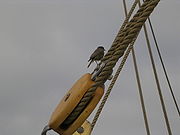
Block (sailing)
Encyclopedia

In sailing
Sailing
Sailing is the propulsion of a vehicle and the control of its movement with large foils called sails. By changing the rigging, rudder, and sometimes the keel or centre board, a sailor manages the force of the wind on the sails in order to move the boat relative to its surrounding medium and...
, a block is a single or multiple pulley
Pulley
A pulley, also called a sheave or a drum, is a mechanism composed of a wheel on an axle or shaft that may have a groove between two flanges around its circumference. A rope, cable, belt, or chain usually runs over the wheel and inside the groove, if present...
. One or a number of sheave
Sheave
A sheave is a wheel or roller with a groove along its edge for holding a belt, rope or cable. When hung between two supports and equipped with a belt, rope or cable, one or more sheaves make up a pulley. The words sheave and pulley are sometimes used interchangeably.A sheave can also refer to a...
s are enclosed in an assembly between cheeks or chocks. In use a block is fixed to the end of a line, to a spar
Spar
In sailing, a spar is a pole of wood, metal or lightweight materials such as carbon fiber used on a sailing vessel. Spars of all types In sailing, a spar is a pole of wood, metal or lightweight materials such as carbon fiber used on a sailing vessel. Spars of all types In sailing, a spar is a...
or to a surface. Rope
Rope
A rope is a length of fibres, twisted or braided together to improve strength for pulling and connecting. It has tensile strength but is too flexible to provide compressive strength...
or line is rove through the sheaves, and maybe through one or more matching blocks at some far end to make up a tackle
Block and tackle
A block and tackle is a system of two or more pulleys with a rope or cable threaded between them, usually used to lift or pull heavy loads.The pulleys are assembled together to form blocks so that one is fixed and one moves with the load...
.
The purchase of a tackle refers to its mechanical advantage
Mechanical advantage
Mechanical advantage is a measure of the force amplification achieved by using a tool, mechanical device or machine system. Ideally, the device preserves the input power and simply trades off forces against movement to obtain a desired amplification in the output force...
. In general the more sheaves in the blocks that make up a tackle, the higher its mechanical advantage. The matter is slightly complicated by the fact that every tackle has a working end where the final run of rope leaves the last sheave. More mechanical advantage can be obtained if this end is attached to the moving load rather than the fixed end of the tackle.
There are various types of blocks that are used in sailing. Some blocks are used to increase mechanical advantage and others are used simply to change the direction of a line. Some blocks ratchet, which means that they turn freely when a line is pulled in one direction but does not turn the other direction. This kind of block makes a line easier to hold, especially on a windy day. They usually have a button or lever to turn the rachet off, turning it into a regular block, allowing lines entering the block move freely in both directions. Ratchet blocks are typically used on small keelboats and dinghies where the mainsheet is and jib sheets are located.
Sailing terms in everyday English
Chock a' block : Refers literally to the situation where pulling on the working line will not raise the load any further because the cheeks of one lifting block are already against the other. Figuratively this has come to mean that something is as full or as far as it can be.See also
- Block and tackleBlock and tackleA block and tackle is a system of two or more pulleys with a rope or cable threaded between them, usually used to lift or pull heavy loads.The pulleys are assembled together to form blocks so that one is fixed and one moves with the load...
- Two six heaveTwo six heave"Two, six, heave" is a phrase used to coordinate seamen's pulling. It derives from the orders used in firing shipboard cannons in the British Royal Navy. The team of six men had numbered roles...
- Portsmouth Block MillsPortsmouth Block MillsThe Portsmouth Block Mills form part of the Portsmouth Dockyard at Portsmouth, Hampshire, England, and were built during the Napoleonic Wars to supply the British Royal Navy with pulley blocks. They started the age of mass-production using all-metal machine tools and are regarded as one of the...

